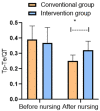Nursing model based on Snyder's hope theory in emergency care of patients with acute myocardial infarction
- PMID: 37560221
- PMCID: PMC10408511
Nursing model based on Snyder's hope theory in emergency care of patients with acute myocardial infarction
Abstract
Objective: To investigate the effect of Snyder's hope theory in emergency care for patients with acute myocardial infarction (AMI).
Methods: This retrospective study included 200 AMI patients admitted to Rugao People's Hospital from January 2019 to December 2021. The patients were divided into a conventional group (routine care, n=100) and an intervention group (care based on Snyder's Hope theory, n=100) according to differences in nursing approach. Baseline data of the two groups were collected. The psychological state was evaluated using the self-rating anxiety scale (SAS) and self-rating depression scale (SDS). Self-care ability was assessed using the exercise of self-care agency (ESCA) scale. The myocardial enzyme indexes including cardiac troponin T (cTnT) and myocardial creatine kinase isoenzyme (CK-MB), as well as electrocardiogram index (Tp-Te/QT) were compared between the two groups. Complications of the two groups were recorded, and the risk factors for complications in the intervention group were examined.
Results: After nursing, the SAS and SDS scores in the intervention group were lower than those in the conventional group (P < 0.05). The ESCA scores in all dimensions were higher in the intervention group than those of the conventional group (P < 0.05). The cTnT and CK-MB decreased in both groups, but the decreases in the intervention group were greater than those of the conventional group (P < 0.05). The Tp-Te/QT in the intervention group (0.25±0.04) was lower than that in the conventional group (0.32±0.06, P < 0.05). The incidence of complications in the intervention group was 9.00%, lower than 21.00% in the conventional group (P < 0.05). Multivariate logistic regression analysis showed that cTnT, CK-MB, and Tp-Te/QT were influencing factors for complications in the intervention group (P < 0.05).
Conclusion: The effect of nursing based on Snyder's hope theory in emergency care fof AMI patients is promising because it can improve the psychological state of patients and reduce the incidence of complications.
Keywords: Acute myocardial infarction; Snyder’s hope theory; nursing effect.
AJTR Copyright © 2023.
Conflict of interest statement
None.
Figures
References
-
- Anderson JL, Morrow DA. Acute myocardial infarction. N Engl J Med. 2017;376:2053–2064. - PubMed
-
- Femia G, French JK, Juergens C, Leung D, Lo S. Right ventricular myocardial infarction: pathophysiology, clinical implications and management. Rev Cardiovasc Med. 2021;22:1229–1240. - PubMed
-
- Gulati R, Behfar A, Narula J, Kanwar A, Lerman A, Cooper L, Singh M. Acute myocardial infarction in young individuals. Mayo Clin Proc. 2020;95:136–156. - PubMed
-
- Tang LH, Harrison A, Skou ST, Doherty P. To what extent are comorbidity profiles associated with referral and uptake to cardiac rehabilitation. Int J Cardiol. 2021;343:85–91. - PubMed
LinkOut - more resources
Full Text Sources
Research Materials
Miscellaneous

